 So in order to talk about this recipe today, we're going to have to talk about sheep butts. I know, not what you were expecting right? But here's the deal, in most parts of the Levant the sheep sort of have this extra butt, almost like a really wide fat tail, that you can see in the pictures. I remember seeing this for the first time near Sayyida Zeinab outside Damascus, and staring at these very weirdly shaped sheep. You see, the sheep are bred this way because that back part is just one big mass of fat. In Arabic this is called 'aliya, and is the traditional cooking fat, sort of like how lard is a traditional cooking fat in the U.S. Nowadays, most people use butter (ghee) or oil in their cooking because it's more cheaply and readily available, but 'aliya is still called for in some dishes.
So in order to talk about this recipe today, we're going to have to talk about sheep butts. I know, not what you were expecting right? But here's the deal, in most parts of the Levant the sheep sort of have this extra butt, almost like a really wide fat tail, that you can see in the pictures. I remember seeing this for the first time near Sayyida Zeinab outside Damascus, and staring at these very weirdly shaped sheep. You see, the sheep are bred this way because that back part is just one big mass of fat. In Arabic this is called 'aliya, and is the traditional cooking fat, sort of like how lard is a traditional cooking fat in the U.S. Nowadays, most people use butter (ghee) or oil in their cooking because it's more cheaply and readily available, but 'aliya is still called for in some dishes. 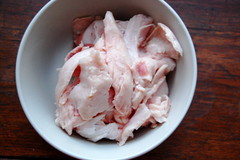

So for today we have a very special kind of kibbeh recipe. It is a kibbeh stuffed with flavored fat, or 'aliya. Since 'aliya isn't readily available, there are several options for your fat: what I do is the next time you cook any fatty piece of lamb (like a leg or shoulder of lamb) trim off the fat, render the fat in a pan, and store it in a covered container in the fridge or freezer. Alternately, you can use some rendered bacon fat mixed with some butter, or you can use all butter.

Now, for this very special kind of kibbeh. This kibbeh is sometimes called "kibbeh zghortawieh," named after a town in Lebanon where this kind of fat-stuffed kibbeh is made. In reality, it's just one restaurant in this town that makes this kibbeh, though it's a destination of sorts. The kibbeh are made very large with thin shells, stuffed with the spiced fat mixture and grilled. You can see a great video of the kibbeh zghortawieh here.
But there are other more home-style ways of making fat stuffed kibbeh, that can vary completely depending on the cook. The two clear rules seem to be the following: the kibbeh are always baked or grilled (since they're packed with fat on the inside, there's no need for frying), and the fat mixture is always flavored with some sort of spice or herb mixture. Annisa Helou describes a lovely version called kibbeh kubab here. I once had one stuffed with some sort of mint-cinnamon-allspice mixture that was delicious.
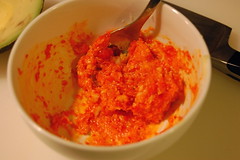
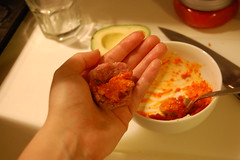
My recipe here uses a pepper paste, which turn the insides a beautiful red and lends a slight sweetness to the kibbeh. They are some of the most delicious kibbeh I've had, little meatballs bursting with moisture and flavor. I do have one note of caution: you need to form the kibbeh very well, pounding the meat to a sticky paste and forming the shells without any gaps. I'll admit I was in a rush to make dinner, and as is obvious in the photo, the fat leaked out of many of my kibbeh. They were still delicious though, and I guess I spared us a few calories in this rich dish.
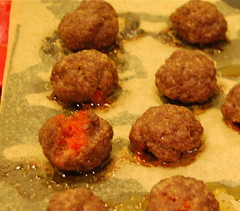
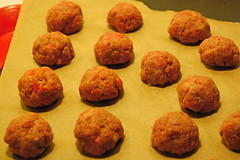
Kibbeh with Rich Red Pepper Stuffing
For the fat you can use rendered lamb fat, a mixture of bacon fat and butter, or all butter or ghee. Generally is is better to use the meat fats because the butter tends to run everywhere and get a bit messy. For the red pepper paste, if you don't use your own a store bought one (like ajvar) will do, just make sure it's not to watery. Feel free to experiment with the recipe and try other flavorings for the filling as well.
4 tablespoons fat (see headnote), at room temperature
2 tablespoons red pepper paste
1/2 a medium onion, grated on a box grater or pureed in a processor
1 lb ground lamb or beef
1 cup fine bulgur
2 teaspoons each allspice, cinnamon
sprinkling each of cloves, black pepper
salt to taste (I start with 1 teaspoon)
1. Mix the fat and the pepper paste, place in the fridge to chill.
2. Meanwhile place bulgur in a fine mesh strainer and rinse in several turns of water, then set aside to drain. Fluff the bulgur, then add to the remaining filling ingredients (onion, meat, spices). Knead the mixture well with you hands until it forms a sticky paste (dampen your hands with cold water if it gets too sticky).
3. Preheat oven to 450 F. Line a baking sheet with parchment paper.
4. Begin forming the kibbeh balls, use your thumb to work the shell mixture into a smooth hollow round in the palm of your hand. Place a small amount of fat in the middle of the kibbeh (about 1/2 tablespoon), then seal the kibbeh very well so there are no holes. Dampen you hands as you work to keep the meat from sticking. Once the kibbeh are formed, it helps to chill them for one hour before baking if you have the time.
5. Bake the kibbeh until browned on the exterior, about 12 minutes for small kibbeh balls (use you judgement, the time may vary depending on the size of the kibbeh). Serve immediately.

Fascinating! That photo of the sheep blows my mind. I'd imagine the flavoring from the sheep fat must be very rich and savory - delicious for winter!
ReplyDeleteyou blow my mind!! I have lived in Lebanon until I moved to the states 3 years ago and I never ever wanted to try kibbe zghortawiyeh till now!!! love your blog
ReplyDeleteThese look and sound delicious! Mercedes, do you know any place either in Baltimore or around here to get some middle eastern ingredients? I really want to try cooking more of this!
ReplyDeletelooks yummy! greasy but yummy!
ReplyDelete